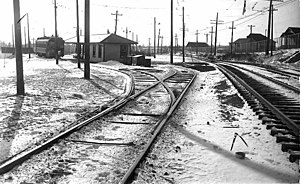Long Branch Loop (Toronto)

The Toronto Transit Commission's Long Branch loop is the westernmost stop on its longest streetcar line, the 501 Queen line in Toronto, Ontario.[1][2] The companies that operated streetcar service along Lake Shore Boulevard originally operated a single track line, with sidings to allow vehicles going in opposite directions to pass one another.[3] The TTC double-tracked the route, and first operated a loop at Long Branch on December 28, 1928.[4]
In 1973 the Long Branch line was described as Toronto's only suburban streetcar line.
The TTC operated a separate Long Branch line up until 1994. It used the Long Branch loop, and the Humber loop for vehicles to turn around. When the Long Branch line was merged with the 501 Queen line the Branch loop became the terminus of the longest streetcar line in North America.[1]
In 2011 the Canadian Broadcasting Corporation broadcast a 14 minute semi-autobiographical short film entitled Long Branch.[5] The film shows two strangers, who were about to share a "one night stand" have their plans fall apart, as the distance to the Long Branch loop was too far, and they had too much time to talk to one another first. The film-makers were a couple, and one member of the film-making couple did live at the Long Branch loop, and said his partner routinely decline to come home with him, because of the distance.
Connecting bus routes
The TTC, and later Mississauga Transit, have used the loop as an interchange point with buses since at least 1935.[6] In 1935 when widening Lake Shore Boulevard west of Etobicoke Creek required the removal of the single track service to Port Credit the TTC replaced the streetcar route with the Port Credit 74 bus route, which ran until 1976.
Mississauga Transit's 5 Dixie and 23 Lakeshore buses terminate at the Long Branch loop.[7]
In addition to the TTC's Port Credit 74 route, other TTC bus routes that terminated at the Long Branch loop include the West Mall 87 route
| route | started | ended | route status |
|---|---|---|---|
| Port Credit 74 | 1935 | 1976 | route cancelled |
| Queensway 69 | 1949 | 1963 | route cancelled[8] |
| West Mall 87 | 1972 | 1980 | route
|
| 501 Queen | To Neville Park Loop | Late evening service only |
| 507 Long Branch | To Humber Loop | No late evening service |
| 508 Lake Shore | To Parliament Street | Rush hours only |
| 301 Queen | To Neville Park Loop | Blue Night service replacing 501 streetcar |
| 110A Islington South | To Islington station | Bus via 30th Street and Horner Avenue |
| 110B Islington South | To Islington station | Bus via Brown's Line and Horner Avenue (rush hour service) |
| 123B Sherway | To Kipling station | Bus via Brown's Line, Sherway Gardens, the East Mall and Shorncliffe |
| 123C Sherway | To Kipling station | Bus via Sherway Gardens and North Queen Street |
References
- ↑ 1.0 1.1 Vanessa Farquharson. Riding the 501: The longest streetcar route in North America, National Post, 2012-03-24. “The loop here is slightly more interesting than its Neville and Humber counterparts — there’s a colourful streetcar mural on a wall, a proper TTC sign that says Long Branch, washrooms and a Legion Hall nearby.”
- ↑ James Bow. Westerly Long Branch Loop, Transit Toronto, 2006-11-10. Retrieved on 2013-07-14. “It is only important to note that tracks reached Etobicoke Creek and the present site of today’s Long Branch Loop in 1895. It would be another thirty-three years before the loop would come into being. Long Branch Loop came into being in on December 8, 1928 when the TTC extended ‘city’ tracks from the Humber River along Lake Shore Boulevard to this site.”
- ↑ Mike Filey. Toronto: The Way We Were, Dundurn Press, 2008, p. 194. Retrieved on 2013-07-14. “In 1920 Toronto purchased this and other privately owned electric radial lines operating outside the city and turned their operations over to Ontario Hydro. Eventually, these lines became part of the recently organized Toronto Transportation Commission. The Commission's streetcar route along Lakeshore Road was soon double-tracked all the way west to the site of the present Long Branch loop, while the roadway itself was widened considerably.”
- ↑ Wheels of Progress: A Story of the Development of Toronto and Its Public Transportation Services, Toronto Transit Commission, 1942, p. 115. Retrieved on 2013-07-14.
- ↑ Steve Kupferman. Filmmakers Turn TTC Inconvenience into Fodder for Romance: A short film explores the bright side of a long, cold commute., The Torontoist, 2012-11-13. Retrieved on 2013-07-14. “It’s the story of Lynn, a young woman who tries to go home with a guy for a one-night stand, only to find out, after she’s already hopped transit with him, that he lives in Long Branch, where subways fear to tread. The pair have no choice but to talk to each other during the agonizingly long ride. And talking, as Lynn points out repeatedly, is not what one-night stands are about.”
- ↑ Pete Coulman. 74 Port Credit (1935-1976), Transit Toronto, 2011-05-16. Retrieved on 2013-07-14. “Due to highway widening, the PORT CREDIT radial car line was discontinued after the last trip on February 9. New PORT CREDIT bus route starts operating between Long Branch Loop via Lakeshore Road to Mississauga Road, wyeing and returning.”
- ↑ Robert Mackenzie. MiWay revises services, January 28, Transit Toronto, 2013-01-27.
- ↑ Peter Coulman, Alan Gryfe, Jeffrey Kay. [http://transit.toronto.on.ca/bus/routes/69-queensway-19.shtml 69 Queensway (1947-1963) (Last Modified on May 16, 2011 10:58 PM)], Transit Toronto, 2011-05-16. Retrieved on 2013-07-14. “Service extended west on the Queensway and then south on Brown’s Line to Long Branch loop.”
